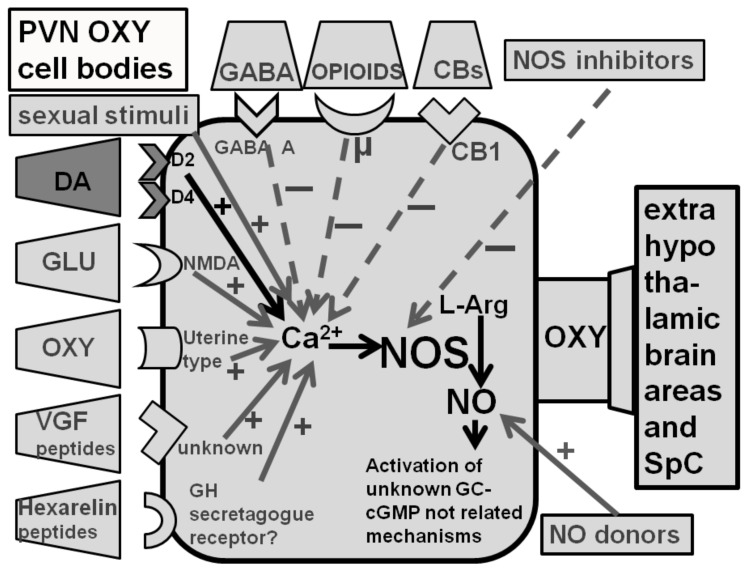Figure 2.
Dopamine facilitates penile erection by activating central oxytocinergic neurons in the PVN. The main mechanism by which dopamine and dopamine D2-like receptor agonists (D2 and D4 receptor subtypes) facilitate penile erection and copulatory activity is the activation of oxytocinergic neurons that originate in the paraventricular nucleus of the hypothalamus (PVN) and project to the spinal cord (SpC) and extra-hypothalamic brain areas. Briefly, dopamine, (DA) by acting on D2 and D4 receptors located in the cell bodies of these oxytocinergic neurons, increases Ca2+ ions influx in these cell bodies, causing in turn the activation of nitric oxide synthase (NOS), a Ca2+ calmodulin-dependent enzyme present in oxytocinergic cell bodies which converts the amino acid L-arginine (L-Arg) to nitric oxide (NO). NO in turn activates oxytocinergic neurons that release oxytocin in the spinal cord and in extra-hypothalamic brain areas to induce penile erection and facilitate sexual behavior by a mechanism that does not involve the guanylate cyclase-cyclic guanosine monophosphate (GC-cGMP) pathway. These oxytocinergic neurons facilitate penile erection and copulatory behavior when activated by dopamine (pathway shown in black) and by other substances, i.e., oxytocin, NMDA, hexarelin and VGF peptides and by drugs that increase PVN NO content (NO donors) by the blockade of PVN CB1 receptors (which are not located on oxytocinergic cell bodies but when blocked stimulate the activity of the latter ones by increasing glutamatergic neurotransmission in the PVN) and by physiological sexual stimuli (i.e., pheromones) (pathways indicated in gray). Conversely, when the activity of these oxytocinergic neurons is inhibited, for instance by GABA, opioid peptides/opiate drugs or drugs that inhibit NO synthase activity, the spontaneous (e.g., physiologically activated) or drug/neuropeptide-stimulated erectile function and copulatory activity is reduced (pathways also indicated in gray) (for references see [82,100,101,102]). This figure is an adapted version of a figure published by the authors in [102].

